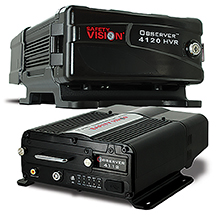
Hybrid video recorders: a new solution
By Steven Winnefeld
 The technology for onboard mobile surveillance systems continues to evolve. Robust analog technology has been employed for many years, and now recently network IP cameras and recorders have gained momentum in transit industry vehicles, promoting enhanced video resolution and many new features. However this transition in recording formats is not happening instantaneously. Often the excitement of seeing high definition video is quickly tempered by looking at the price tag and considering the logistics of updating a large fleet. Addressing these concerns is a new breed of video recorder; hybrids combine both analog and network inputs to create another option for onboard video recording. How can these new systems benefit you?
The technology for onboard mobile surveillance systems continues to evolve. Robust analog technology has been employed for many years, and now recently network IP cameras and recorders have gained momentum in transit industry vehicles, promoting enhanced video resolution and many new features. However this transition in recording formats is not happening instantaneously. Often the excitement of seeing high definition video is quickly tempered by looking at the price tag and considering the logistics of updating a large fleet. Addressing these concerns is a new breed of video recorder; hybrids combine both analog and network inputs to create another option for onboard video recording. How can these new systems benefit you?
Analog
Analog camera systems have been utilized in the mobile surveillance industry since its inception. Originally recording to video tape, they evolved to using digital storage media. Analog transmits the image and audio to the recorder, which must then process these signals into video. Typical analog system image resolution is limited to 720 x 480 pixels, otherwise known as D1. The video signal uses interlaced video frames to reduce bandwidth, and this often causes problems as rapidly moving objects can appear blurry. However, the cables and their connectors, typically BNC and Molex-type, are easily recognizable on vehicles and familiar to all maintenance and installation technicians. And due to its wide adoption, analog components are increasingly cost-effective.

Network
Network camera systems are increasingly gaining traction in mobile environments over the past few years. IP cameras process image and audio into video in the camera itself, which then transmits this video to a network video recorder via a singular Ethernet cable. They provide high definition resolution, often at 1080p (1,920 x 1,080 pixels) like many home televisions – which produces some stunningly sharp images, and motion blur is reduced using progressive scanning. Those benefits come at the cost of large amounts of data that must be transmitted and stored by the recorder and video management software, driving up prices. Since the security industry is just recently adapting digital technology to mobile environments, installers and operators are learning new hardware, tools and methods.
Hybrid
Hybrid video recorders, such as Safety Vision’s Observer™ 4112 and 4120 models, combine both analog and network technology to create an additional choice. On the back of these systems, you will find a series of analog connections and an Ethernet port. Four IP cameras can be connected to a switch, which then connects to the Ethernet port, augmenting the analog cameras. The Foresight PRO software seamlessly plays back video from all of the cameras in one video file.
Hybrids present an ideal solution to the problem of upgrading from analog to network systems. Upgrading an entire fleet at once is an immense operational cost, as all of the old analog components must first be removed and a network infrastructure is installed in their place. Instead, hybrids can be installed in mid-life buses so as to allow the continued use of the analog cameras and cables. Where more definition is needed from video cameras, up to four additional or replacement HD cameras can be installed in critical positions. The gradual conversion to full IP camera bus networks costs less as older buses due to be decommissioned can take advantage of hybrid technology using existing analog camera infrastructure.
Expenses can also be controlled in installations by strategically placing network IP cameras where they are most effective. An IP camera pointed out of the front windshield will capture the long field of view ahead of the bus, and the resolution allows you to zoom in on fine objects such as license plates and signs. Other locations that benefit from this zoom are doors and fareboxes. Multiple analog cameras can efficiently capture shorter distances in the bus interior, minimizing the overall system cost.
These situations illustrate the immediate benefits hybrid video recorders can provide. They are “the best of both worlds,” taking advantage of the incredible resolution of network IP cameras and the cost-effectiveness of analog systems to create a new flexible solution with new surveillance possibilities.
Steven Winnefeld is documentation specialist for Safety Vision, LLC, a pioneer in mobile video surveillance systems. Safety Vision prides itself on its institutional knowledge. Visit Safety Vision at www.safetyvision.com. For a complete set of references please visit: http://bit.ly/1IwdQCu.
